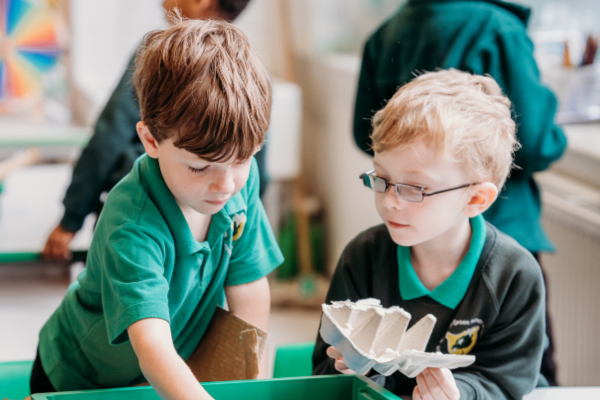How can Explorify help you teach children about materials
Explorify has many activities to help you teach children about Materials. Find out more about the activities and how they can help children build their long-term memory.

Explorify gets children talking and thinking. Some activities are particularly useful for formative assessment; teachers can easily find out what children already know about the learning focus, including uncovering misconceptions and identifying strengths in children's prior knowledge. This helps to plan future lessons. Some activities allow children to revisit and consolidate what they have learnt during the unit. This helps children remember and deepen their understanding.
Accompanying the Materials resources are two guides with suggestions about how to use the activities for retrieval practice for 5 to 7 years old and 7 to 12 years old.
In Autumn 2022, Explorify Engagement Leaders worked with a group of teachers to trial the use of Explorify activities purposefully for retrieval practice. All the teachers who responded to our questionnaire at the end of the trial agreed that Explorify had a positive effect on consolidating long-term memories. Read about it here. The lessons learnt from that trial have been used to prepare new materials resources.
Key vocabulary
Two glossaries covering the key words children need to learn have been created for 5 to 7 year-olds and 7 to 12 year-olds. These cover the difference between words like strong and hard and vocabulary like thermal and electrical insulation.
Learning about Materials (5 to 7 years)
Children need to learn the difference between an object and a material. An object is something that you can touch. A material is what the object is made from. Also watch out for children using the word material to describe fabric, rather than understanding that the word covers what all things are made from.
The activity Odd One Out A bowl full features three familiar bowls made of different materials and gets the children talking about the differences and which is the odd one out. Afterwards, take the children for a walk around school and identify similar objects made from different materials. You could use Fascinating forks once you have taught the objective to check for understanding and deepen their memory.
There are Zoom In, Zoom Outs featuring different materials to get the children identifying and discussing the properties of metal (Celebrating success), plastic (In disguise), water (See through) and rock (Hard crust). The Odd One Out Fit for purpose is great for discussing the suitability of different materials. Check out the suggestions in the Take It further section. Flexible solids and How long? explore how different materials can be changed by applying force.
Solids, liquids and gases
There are lots of high-quality activities focusing on solids, liquids and gases, all designed to help the children understand their key properties and to tease out common misconceptions. Pouring fun has images of sand, milk and rice being poured. Which are solids and which are liquids? To take it further, give the children a collection of materials to examine. Suggest that they pour materials into differently shaped containers (including wide, shallow trays) and look closely to see if they always take the shape of the container. Draw children’s attention to the fact that even if they only have a small quantity of liquid, that doesn’t fill the bottom of a wide, shallow container, liquids will form flat ‘pools’ while solids will form piles. The What’s Going On? Pouring liquids has oil, syrup and tomato sauce moving down a slope. It could prompt children to ask questions and investigate further.
There are two Odd One Out activities focused on the properties of gases: Gas filled and Inflating fun. Although we can’t see air, the What’s Going On? films Air in or air out? and Wet or dry? both suggest simple ways for children to demonstration that it is a material. Sometimes it is difficult to decide if something is a solid, liquid or gas. The Odd One Out Is it a liquid? will really get the children thinking and should prompt a rich discussion.
Changing States
Once children understand the properties of solids, liquids and gases they learn about the process of changing states. The Odd One Out Wonderful Water shows water in all three states. Can the children make the connections? There are Zoom In, Zoom Outs that highlight melting, evaporation and condensation: Glistening brown features butter melting on a piece of toast. Golden wrinkles is a dried raisin. How many children can make the connection with evaporation? Shiny patterns is water vapour condensing on a bathroom tap. Make sure you read the Watch out for… sections which help with common misconceptions.
For teaching the Water Cycle, there are these activities; a What’s Going On? Never ending story and a Big Question What are clouds made of?
Properties of materials (7 to 12 years)
As children develop their understanding of how materials behave, they can investigate the suitability of materials for different purposes. What are my properties? and Useful rocks focus on properties, and the Take It Further sections across all resources give you ideas for investigations in the classroom.
Reversible and irreversible changes
How can we speed up dissolving? and Seive or filter? are activities about reversible changes. There are many other good irreversible change activities as well, all with the usual Background Science and Take It Further sections. Have a look at Bright spark and 3-2-1 lift off! This Who is? activity links nicely to irreversible changes; Who is Eunice Newton Foote? She was the first person to discover that carbon dioxide trapped heat.
